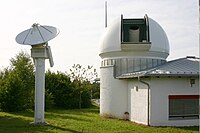
Photo from wikipedia
The GaoFen-7 (GF-7) satellite, which is used for Earth observations, is equipped with China’s first civil full-waveform laser altimeter. The geometric calibration of the GF-7 satellite laser is vital for… Click to show full abstract
The GaoFen-7 (GF-7) satellite, which is used for Earth observations, is equipped with China’s first civil full-waveform laser altimeter. The geometric calibration of the GF-7 satellite laser is vital for ensuring its long-term stability and highly precise global measurements. In this study, a geometric of calibrating satellite laser is proposed. Notably, this method does not require an outdoor calibration field but instead relies on a mathematical surface model. This calibration method converts that to calibrate laser pointing angle error in traditional calibration method to calibrate the three-axis rotation angle error between the laser frame and the satellite body fixed-frame. Assuming that the laser footprints always fall on a fit spatial plane, a new satellite laser geometry calibration model is established. In addition, the GF-7 satellite laser is calibrated by using airborne light detection and ranging (LiDAR) point clouds collected from the sloped terrain of Xinjiang. Taking the laser footprints that are captured by the laser ground detectors as the true values, the positioning error of GF-7 beam 1 is improved from 430 m before calibration to 1.8 m after calibration. And the beam 2 positioning error is improved from 1025 to 6.4 m. Finally, according to the surface elevation of the laser footprints that were measured by a real-time kinematic, the elevation error of the GF-7 laser on flat terrain was verified to be 0.14 m after calibration. In summary, the calibration method proposed in this study is effective and feasible and provides a new method for satellite laser calibration.
Journal Title: IEEE Transactions on Geoscience and Remote Sensing
Year Published: 2023
Link to full text (if available)
Share on Social Media: Sign Up to like & get
recommendations!